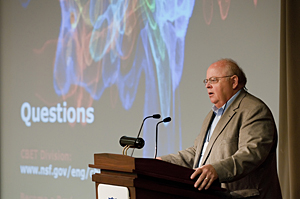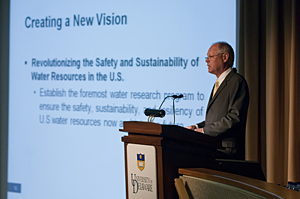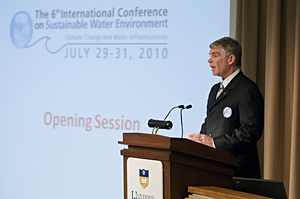

ADVERTISEMENT
- Rozovsky wins prestigious NSF Early Career Award
- UD students meet alumni, experience 'closing bell' at NYSE
- Newark Police seek assistance in identifying suspects in robbery
- Rivlin says bipartisan budget action, stronger budget rules key to reversing debt
- Stink bugs shouldn't pose problem until late summer
- Gao to honor Placido Domingo in Washington performance
- Adopt-A-Highway project keeps Lewes road clean
- WVUD's Radiothon fundraiser runs April 1-10
- W.D. Snodgrass Symposium to honor Pulitzer winner
- New guide helps cancer patients manage symptoms
- UD in the News, March 25, 2011
- For the Record, March 25, 2011
- Public opinion expert discusses world views of U.S. in Global Agenda series
- Congressional delegation, dean laud Center for Community Research and Service program
- Center for Political Communication sets symposium on politics, entertainment
- Students work to raise funds, awareness of domestic violence
- Equestrian team wins regional championship in Western riding
- Markell, Harker stress importance of agriculture to Delaware's economy
- Carol A. Ammon MBA Case Competition winners announced
- Prof presents blood-clotting studies at Gordon Research Conference
- Sexual Assault Awareness Month events, programs announced
- Stay connected with Sea Grant, CEOE e-newsletter
- A message to UD regarding the tragedy in Japan
- More News >>
- March 31-May 14: REP stages Neil Simon's 'The Good Doctor'
- April 2: Newark plans annual 'wine and dine'
- April 5: Expert perspective on U.S. health care
- April 5: Comedian Ace Guillen to visit Scrounge
- April 6, May 4: School of Nursing sponsors research lecture series
- April 6-May 4: Confucius Institute presents Chinese Film Series on Wednesdays
- April 6: IPCC's Pachauri to discuss sustainable development in DENIN Dialogue Series
- April 7: 'WVUDstock' radiothon concert announced
- April 8: English Language Institute presents 'Arts in Translation'
- April 9: Green and Healthy Living Expo planned at The Bob
- April 9: Center for Political Communication to host Onion editor
- April 10: Alumni Easter Egg-stravaganza planned
- April 11: CDS session to focus on visual assistive technologies
- April 12: T.J. Stiles to speak at UDLA annual dinner
- April 15, 16: Annual UD push lawnmower tune-up scheduled
- April 15, 16: Master Players series presents iMusic 4, China Magpie
- April 15, 16: Delaware Symphony, UD chorus to perform Mahler work
- April 18: Former NFL Coach Bill Cowher featured in UD Speaks
- April 21-24: Sesame Street Live brings Elmo and friends to The Bob
- April 30: Save the date for Ag Day 2011 at UD
- April 30: Symposium to consider 'Frontiers at the Chemistry-Biology Interface'
- April 30-May 1: Relay for Life set at Delaware Field House
- May 4: Delaware Membrane Protein Symposium announced
- May 5: Northwestern University's Leon Keer to deliver Kerr lecture
- May 7: Women's volleyball team to host second annual Spring Fling
- Through May 3: SPPA announces speakers for 10th annual lecture series
- Through May 4: Global Agenda sees U.S. through others' eyes; World Bank president to speak
- Through May 4: 'Research on Race, Ethnicity, Culture' topic of series
- Through May 9: Black American Studies announces lecture series
- Through May 11: 'Challenges in Jewish Culture' lecture series announced
- Through May 11: Area Studies research featured in speaker series
- Through June 5: 'Andy Warhol: Behind the Camera' on view in Old College Gallery
- Through July 15: 'Bodyscapes' on view at Mechanical Hall Gallery
- More What's Happening >>
- UD calendar >>
- Middle States evaluation team on campus April 5
- Phipps named HR Liaison of the Quarter
- Senior wins iPad for participating in assessment study
- April 19: Procurement Services schedules information sessions
- UD Bookstore announces spring break hours
- HealthyU Wellness Program encourages employees to 'Step into Spring'
- April 8-29: Faculty roundtable series considers student engagement
- GRE is changing; learn more at April 15 info session
- April 30: UD Evening with Blue Rocks set for employees
- Morris Library to be open 24/7 during final exams
- More Campus FYI >>
2:17 p.m., Aug. 3, 2010----The Sixth International Conference on Sustainable Water Environment opened at the University of Delaware's Clayton Hall on Thursday morning, July 29, with nearly 200 participants from six continents in attendance.
The conference continued through Saturday morning, during which time 130 technical papers and 60 posters were presented, as well as two sessions on future research needs in both natural and built systems to ensure water security and sustainability.
“Water is the most important natural resource,” said C. P. Huang, Donald C. Phillips Professor of Civil and Environmental Engineering and chair of the international organizing committee for the conference. “It is a necessary substance for life and there is no substitute for it. This conference is focusing on strategies and technologies for ensuring the sustainability of water resources around the world in a time of climate change.”
This is the first time the conference has been held in North America. Previous meetings have been held in Taiwan, Japan, Singapore and Korea.
UD President Patrick Harker welcomed the participants to Delaware, saying, “The entire University of Delaware community is deeply proud to serve as your host.”
In his remarks, Harker noted some sobering facts that illustrate the urgent need for safe and sustainable water resources around the world:
- 1.1 billion people live without clean drinking water.
- 2.6 billion people lack adequate sanitation.
- 1.8 million people die every year from diarrheal diseases.
- 3,900 children die every day from water-borne diseases.
- The world's population tripled in the 20th century, while the use of renewable water resources grew six-fold.
Meeting humanity's water needs
Paul L. Bishop, professor of environmental engineering at the University of Cincinnati and environmental engineering program director for the National Science Foundation (NSF), gave the first keynote address.
According to Bishop, traditional sources of freshwater -- lakes, rivers, and groundwater -- will not be enough to meet humanity's needs in the coming decades, and we will need to develop new ways of conserving and reusing our water resources. He cited Israel, a country that reuses more than 70 percent of its water, as an example of what can be achieved with public acceptance of water reuse.
“The benefits of water reuse are that it provides a dependable source that is a reliable quality, locally controlled, and environmentally friendly,” he said. “It has low capital costs relative to other sources and in terms of energy use.”
He said the biggest problems we face with water reuse are pharmaceutical compounds in wastewater, the expense of replacing or adapting some urban infrastructure, and overcoming institutional barriers between water and wastewater utilities. Public perception of reused water as being poor quality can be overcome with education, he said.
“Properly treated, the quality of reused water is usually at least as good as other sources,” he said.
The 'water-energy nexus'
Bishop also discussed the interrelationship between water and energy use, which he called the “water-energy nexus.”
“Production of energy requires large amounts of water,” he said, “and treatment and distribution of water require large amounts of energy.”
Bishop said that energy generation accounts for 39 percent of all freshwater withdrawals in the United States. Each kilowatt of power generated from coal requires 25 gallons of water. The amount of water used to produce household electricity exceeds direct household water use.
“The number of gallons per person per day in the United States for all uses, including food production and electricity generation, amounts to more than 1,000 gallons per day,” he said.
He noted that the primary use of energy in water treatment and distribution is for pumping, and often water is pumped long distances to reach urban and arid areas, such as the southwest United States, where water supplies are most critical and population growth is high.
“About a third of the energy used by municipalities is used for water and wastewater treatment,” Bishop said. “The amount of energy use is even affected by the age of the pipes. Older pipes have more friction along their walls and require more energy to pump water through.”
Many alternative means of acquiring and treating water are also energy intensive, according to Bishop. Energy accounts for 40-60 percent of the cost of desalination, for example. Treatment processes involving membranes (reverse osmosis) or heat (distillation) also require significant amounts of energy. And some alternative energy sources such as biofuels require large amounts of water for growing the crops from which they are derived.
Climate change further complicates the picture by shifting the amounts of water available in various places around the world. To illustrate this point, Bishop cited a joint NSF/China initiative to study the impact of climate change on water resources in western China, where rivers are fed by Himalayan glaciers that are rapidly receding. As the glaciers disappear, there will be a corresponding decrease in the water supply to the Yangtze River and the Three Gorges Dam, currently a major energy source for China.
In conclusion, Bishop pointed out that solving the associated problems of the water-energy nexus is a national defense issue for most countries, since food production, human health, industries including manufacturing and tourism, and household life depend on clean and safe water and energy supplies.
Safety, sustainability research program
A second keynote address was presented by Charles I. Noss, the national program director for water quality at the Office of Research and Development (ORD) of the U.S. Environmental Protection Agency, who announced for the first time outside of the EPA a new safety and sustainability research program for U.S. water resources.
According to Noss, the EPA's past approach to water quality has been oriented toward risk assessment and management, often on a toxin-by-toxin basis. He said the new direction taken by the agency will be more interdisciplinary, collaborative, flexible, and transparent. The current 14 national ORD research directorates will be collapsed into four broader areas.
Noss said that the new administration in Washington, D.C., and the new EPA administrator, Lisa P. Jackson, have restructured the agency's priorities to take action on climate change, improve air quality, assure the safety of chemicals, clean up communities, protect the nation's waters, work for environmental justice, and build strong state and tribal partnerships.
“In terms of water resources, our goal will be to preserve and restore and recycle and reduce use as much as possible,” he said. In the area of drinking water, Noss said that his program would seek to address contaminants as a group rather than one at a time, foster the development of new techniques in water treatment, use the authority of multiple statutes to protect water quality, and partner with the states to share more complete data from public water supply monitoring.
Noss highlighted Chesapeake Bay as an example of a resource that the EPA strives to protect. The bay's biggest problem is nitrogen enrichment, which comes from three roughly equal sources: agricultural runoff, atmospheric deposition from the burning of fossil fuels, and municipal wastewater.
“You can't solve the Chesapeake's problems with just one focus,” Noss said. “Solutions need to involve a variety of stakeholders -- federal and state agencies, education and research institutions, watershed authorities, representatives from agriculture, industry, and municipalities.”
The new direction of the EPA includes sustainability as a goal, he said. “We want to solve current problems without creating new problems.”
Following the meeting, conference chair C. P. Huang and Chip Elliott of Penn State University are serving as guest editors of a special issue in the Journal of Separation and Purification Technology titled “Technology for a Sustainable Water Environment,” to be published by Elsevier.
The Sixth International Conference on Sustainable Water Environment was sponsored by the National Science Foundation, the U.S. Environmental Protection Agency, the Environmental Water Research Institute of the American Society of Civil Engineers, the Delaware Department of Natural Resources and Environmental Control, the Chinese-American Professors in Environmental Engineering and Science, and the University of Delaware's Department of Civil and Environmental Engineering, the Delaware Environmental Institute, the College of Engineering, and the Institute for Global Studies.
Article by Beth Chajes
Photos by Doug Baker



